- Home >
- Products >
- Technical Highlight >
- Vol.25: B91 Series welding consumables for Grade 91 steels
Technical Highlight Vol.25
Vol.25: B91 Series welding consumables for Grade 91 steels

1.Preface
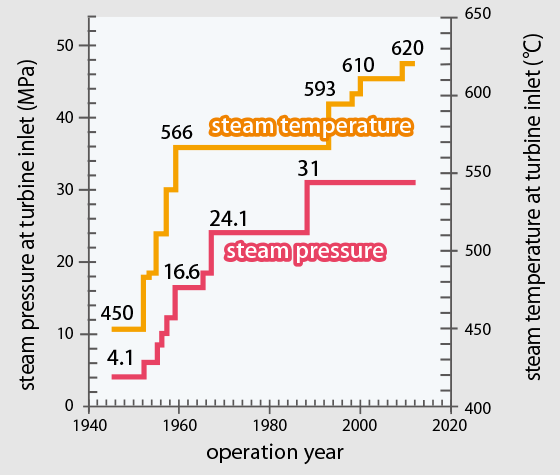
Figure 1: Steam pressure and temperature for thermal
power generation in Japan
The biggest concern in the field of thermal power generation is the reduction of CO2 emissions. However, the most effective way of achieving that is to improve the efficiency of power generation, which requires steam at high temperature and pressure to be fed into power generating turbines. In Figure 1, it can be seen that steam conditions (temperature and pressure) at thermal power generation plants in Japan have trended up over the decades.
Thermal power generation plants, therefore, require special steels that can be utilized for long periods under such high temperature and pressure steam conditions, such as high chromium (Cr) ferritic heat resisting steels containing 9-12% Cr. Grade 91 (Gr. 91) steel is the main high Cr ferritic steel that has been put into practical service in thermal power plant boilers worldwide. KOBE STEEL,LTD. (KSL) has developed and marketed both 9Cb Series and B9 Series consumables for welding Gr. 91 steels, and they have been well-received by many domestic and overseas boiler fabricators.
On the other hand, an issue concerning high Cr ferritic steel is the combined amount of Mn+Ni, which has gradually come to be a subject of regulation. For example, such international standards bodies as ASME and AWS have started to review the issue accordingly.
The B91 Series consumables, developed in accordance with these concerns, will be discussed as products corresponding to the AWS standards.
2.International standards
In recent years, international standards bodies have moved to continuously modify requirements for both the Mn+Ni content and the post weld heat treatment (PWHT) temperature.
Tables 1 and 2 show the trends of ASME B31.1 and AWS B9/B91 standards respectively.
| Year | Mn+Ni content(mass %) | Upper limit of PWHT temperature at actual procedure (℃) |
Reference(Year of revision) | |
|---|---|---|---|---|
| Recommended condition | Mandatory condition | |||
| 2008 and before | Not regulated | 760 | Base metal Ac1:about 800 | Table 132 P-No. 5B Group No. 1→ Group No. 2 |
| 2009-2013 | Filler metal unknown | 775 | Base metal Ac1:about 800 | Table 132 P-No. 15E Group No. 1 (2009) |
| 1.0 ≤ Filler metal < 1.5 | 790 | |||
| Filler metal < 1.0 | 800 | |||
| 2014 and after | Filler metal < 1.2 | 775 | Base metal Ac1:about 800 and filler metal A1 or A c1*2 | Table 132 P-No. 15E Group No. 1 (2014) |
| < 1.0 *1 | ー | 125.1.3 (2014) For repair of casting | ||
Note: *1 B9: SMAW, SAW, GTAW and FCAW
*2 A1 or Ac1 in filler metals is determined either by analysis and calculation or by actual measurement
| Year | Upper limit of Mn+Ni content in deposited metal (mass %) *1 | Upper limit of PWHT temperature at specified for testing(℃) | Reference(Year of revision) *2 |
|---|---|---|---|
| Up to 2004 | Not regulated*3 | 759 (SMAW) or 760 | B9: SMAW, GMAW,GTAW (1996)SAW (1997) |
| 2005-2010 | 1.5 or 1.50 | 775 | B9: GMAW, GTAW(2005) SMAW (2006) SAW (2007) FCAW (2010) |
| From 2010 onwards | 1.40 | 775 | B9 deleted → B91 newly established B91: SAW (2011),FCAW (2012) SMAW (2014) *4 |
Note: *1) Wire or cut rod chemistry in case of GMAW and GTAW
*2) AWS Specification No.: SMAW: A5.5; SAW: A5.23; GMAW & GTAW:A5.28; FCAW: A5.36
*3) Sum of both Mn and Ni specified upper limit figures is 2.25
*4) Revision of GMAW and GTAW is under discussion as of May, 2018.
Both tables show that the upper limits for Mn+Ni content have been repeatedly reduced in both sets of standards. In welding Gr. 91 steels, this has allowed the upper limits on the temperature for PWHT, which is essential for reducing residual stress after welding, to be eased higher. Following optimum PWHT, Gr. 91 weld metal exhibits a tempered martensite structure that provides excellent high temperature strength and toughness. However, it is well-understood that once the PWHT temperature exceeds the Ac1 transformation point, fresh martensite transforms back into austenite, and, during cooling, returns to become fresh martensite again, leading to deterioration of creep and toughness properties. Therefore, the content of Mn and Ni needs to be kept low because these elements lower the Ac1 transformation point. (See Figure 2)
3.Chemical compositions and Ac1 transformation point of B91 Series welding consumables
Although 9Cb Series welding consumables are not entirely compatible with AWS specifications because they are designed to obtain comparatively high Mn+Ni content, they have been utilized successfully in domestic and overseas projects in which PWHT temperature requirements have been relatively low. However, in cases where following AWS specifications is mandatory,particularly in overseas projects, these consumables could not be applied.
KSL originally developed and marketed the B9 Series consumables to be compatible with AWS specifications. The B91 Series consumables were later developed to comply with stricter AWS requirements in 2012, especially the ever-stricter limitations on Mn+Ni content.
Table 3 shows the typical chemical compositions of deposited metals and Ac1 transformation points, and Table 4, the typical mechanical properties after PWHT, of the 9Cb and B91 Series consumables, respectively. It can be seen that the B91 Series consumables are designed to provide the designated mechanical properties after PWHT while Mn+Ni content is controlled to be equal to or less than 1.0%, lower than that of the 9Cb Series consumables. Figure 2 shows the relationship between Mn+Ni content and actually measured Ac1 transformation points. It can be seen that typical Ac1 transformation points actually measured with the B91 Series consumables show 800 ℃ or over. Therefore, it is certain that higher PWHT temperatures can be applied.
| Process | Polarity | Consumable | Chemical composition of weld metal (mass%) |
Ac1(℃) | ||||||||||
|---|---|---|---|---|---|---|---|---|---|---|---|---|---|---|
| C | Si | Mn | Ni | Cr | Mo | Nb | V | Co | N | Mn+Ni | ||||
| SMAW | DCEP | CM-9Cb | 0.05 | 0.26 | 1.38 | 0.97 | 9.21 | 1.10 | 0.02 | 0.21 | - | 0.04 | 2.35 | 733 |
| SAW | AC | PF-200S/US-9Cb | 0.07 | 0.13 | 1.55 | 0.67 | 8.54 | 0.89 | 0.04 | 0.22 | - | 0.03 | 2.22 | 750 |
| GTAW | DCEN | TG-S9Cb (100%Ar) | 0.07 | 0.18 | 1.01 | 0.69 | 8.63 | 0.91 | 0.04 | 0.18 | - | 0.02 | 1.70 | 765 |
| GMAW | DCEP | MG-S9Cb (Ar-20%CO2) | 0.08 | 0.27 | 1.29 | 0.38 | 8.86 | 0.98 | 0.03 | 0.19 | - | 0.02 | 1.67 | - |
| SMAW | DCEP | CM-95B91 | 0.09 | 0.23 | 0.71 | 0.10 | 8.40 | 0.99 | 0.06 | 0.21 | 0.42 | 0.03 | 0.81 | 809 |
| SAW | AC | PF-200S/US-90B91 | 0.09 | 0.29 | 0.74 | 0.16 | 8.64 | 1.03 | 0.04 | 0.20 | 0.40 | 0.04 | 0.90 | 808 |
| GTAW | DCEN | TG-S90B91 (100%Ar) | 0.09 | 0.27 | 0.73 | 0.11 | 8.61 | 1.02 | 0.06 | 0.19 | 0.40 | 0.03 | 0.84 | 820 |
| GMAW | DCEP | MG-S90B91 (Ar-5%CO2) | 0.12 | 0.24 | 0.64 | 0.15 | 8.47 | 0.98 | 0.05 | 0.18 | 0.41 | 0.04 | 0.79 | 813 |
| Process | Polarity | Trade Name | PWHT condition | 0.2%OS(MPa) | TS(MPa) | vE+20℃(J) |
|---|---|---|---|---|---|---|
| SMAW | DCEP | CM-9Cb | 750℃x5h | 593 | 756 | 129 |
| SAW | AC | PF-200S /US-9Cb |
740℃x8h | 584 | 709 | 95 |
| GTAW | DCEN | TG-S9Cb (100%Ar) |
740℃x8h | 701 | 777 | > 260 |
| GMAW | DCEP | MG-S9Cb (Ar-20%CO2) |
740℃x8h | 568 | 698 | 120 |
| Process | Polarity | Trade Name | PWHT condition | 0.2%OS(MPa) | TS(MPa) | vE+20℃(J) |
|---|---|---|---|---|---|---|
| SMAW | DCEP | CM-95B91 | 760℃x2h | 593 | 730 | 70 |
| SAW | AC | PF-200S /US-90B91 |
760℃x4h | 578 | 719 | 62 |
| GTAW | DCEN | TG-S90B91 (100%Ar) |
763℃x4h | 579 | 713 | 216 |
| GMAW | DCEP | MG-S90B91 (Ar-5%CO2) |
760℃x8h | 529 | 689 | 74 |
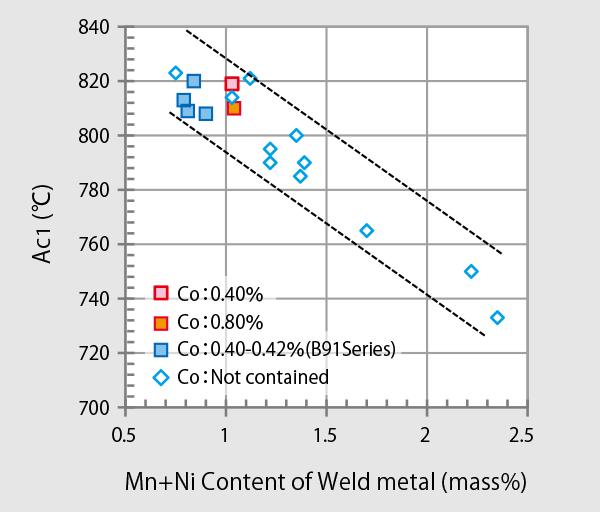
Figure 2: Relationship between Mn+Ni content and Ac1
Another feature of B91 Series consumables is the addition of cobalt (Co). As Figure 2 suggests, the Ac1 transformation point tends to fall in relation to the increase in Mn+Ni content. While the B91 Series consumables contain Co, the element is not likely to affect the Ac1 transformation point; after all, the consumables without Co also show a Ac1 transformation point that decreases in relation to increases in Mn+Ni content. In fact, Co is added for a different reason – restraining delta (δ) ferrite formation. Besides the Ac1 transformation point, another influential factor on the Gr. 91 steels is the formation of δ ferrite structure. Because it is desirable that a weld contains no δ fe rrite structure but 100% martensite structure, the Electric Power Research Institute (EPRI) proposed an index called Cr-Ni balance (CNB) less than 10% in its report No. 1023199 “Guidelines and Specifications for High-Reliability Fossil Power Plants.” The CNB equation is as follows:
CNB = (Cr equivalent) – (Ni equivalent)
= (Cr+6Si+4Mo+1.5W+11V+5Cb+9Ti+12Al) –(40C+30N+4Ni+2Mn+1Cu) < 10 % (mass %)
Although Mn and Ni are known as the austenite forming elements and the CNB equation also shows they can prevent δ ferrite formation, excessive amounts of Mn and Ni are not allowed from the view point of AWS specification as well as Ac1 transformation point. For this reason, Co, another austenite forming element, is added in order to restrain δ ferrite formation without changing Ac1 transformation point.
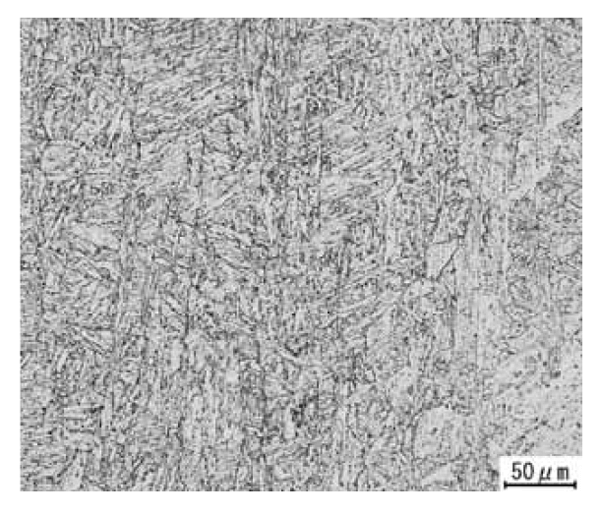
Figure 3: Microstructure of CM-95B91
Figure 3 shows the microstructure of TRUSTARC™ CM-95B91 (AWS A5.5 E9015-B91), one of the B91 Series consumables. The full tempered martensite structure is easily recognized.
4.Mechanical properties of B91 Series consumables
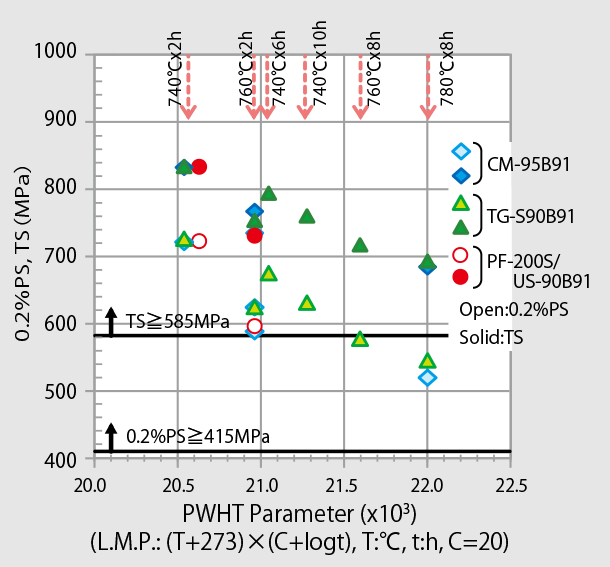
Figure 4: Relationship between L.M.P. and 0.2%P.S., T.S.
Figure 4 shows the relationship between tensile strength (TS), 0.2% offset yield strength (0.2%OS) or 0.2% proof stress (0.2%PS) and the heat treatment parameter, referred to as the Larson-Miller Parameter (L.M.P.), in relation to CM-95B91, TRUSTARC™ TG-S90B91 (AWS A5.28 ER90S-B9) and TRUSTARC™ PF-200S/US-90B91 (AWS A5.23 F9PZ-EB91-B91).
It is clear that these welding consumables fully satisfy the mechanical property requirements of Gr. 91 steels (0.2%PS equal to or more than 415MPa and TS equal to or more than 585MPa) even at L.M.P.=22.0 x 103 equivalent to PWHT parameter of 780℃ x 8 hours (i.e. high temperature and extended time).
Figure 5 shows the relationship between L.M.P. and notch toughness at +20℃.
While notch toughness differs depending on the welding consumables, all consumables exhibit better notch toughness when the L.M.P. is larger. In cases where the L.M.P. exceeds 21.0 x 103, the obtained notch toughness values are sufficient enough for practical use.
Figure 6 shows the creep rupture properties of CM-95B91 and TG-S90B91.
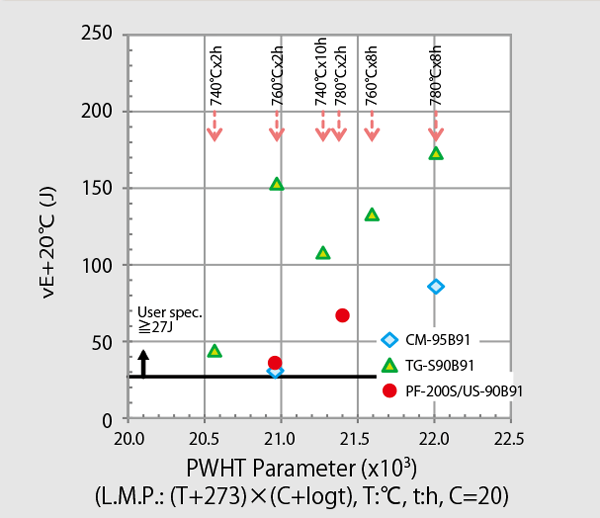
Figure 5: Relationship between L.M.P. and vE+20℃
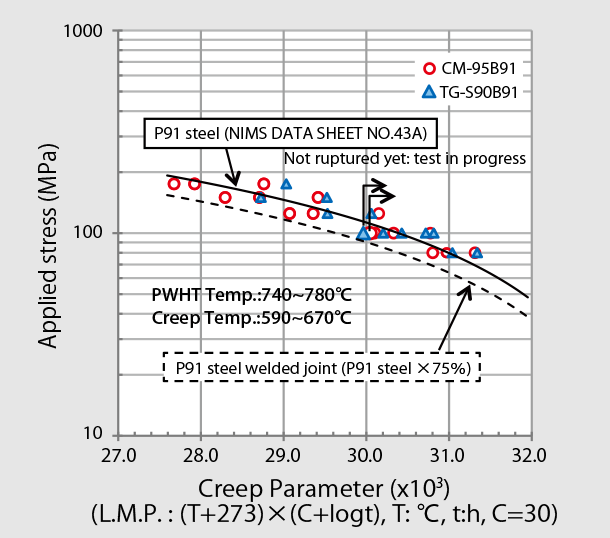
Figure 6: Creep rupture test results of
CM-95B91 and TG-S90B91
It confirms that these consumables provide more sufficient creep rupture properties than those of the butt joint welds (dotted line) even at PWHT temperature as high as 780℃. Testing of the creep rupture properties of these consumables under an extended time creep condition of 600℃ x 100MPa is being carried out. For example, the tests of CM-95B91 and TG-S90B91 have passed 26,000 and 21,000 hours respectively and are still in progress.
5.Usability of the B91 Series consumables
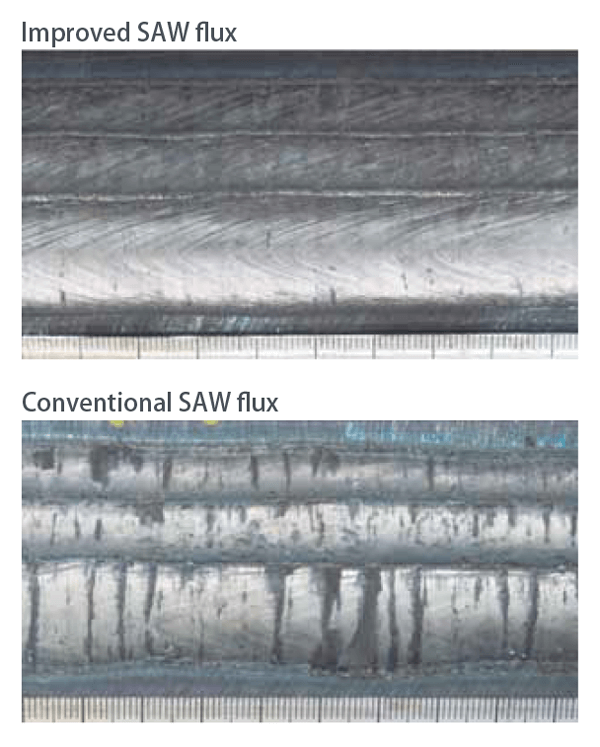
Figure 7: Bead appearance comparison by SAW between
improved fluxes and conventional fluxes with B91 wir
The usability of B91 Series consumables has also been improved. As for covered electrodes for SMAW, alloy core rods are generally used to stabilize the alloying element quality in welds of high-Cr ferritic steels; however, electrode burn frequently happens during welding especially with DC (Direct Current). CM-95B91 is designed to reduce electrode burn and can achieve welding even in a higher range of welding current than the conventional TRUSTARC™ CM-9Cb. A problem peculiar to SAW consumables on high-Cr ferritic steels, namely, the burnt-slag that sticks on weld bead surface, has also been reduced. Figure 7 shows a comparison of bead appearances by SAW with the combination of B91 wire and the newly improved flux, and the conventional flux, respectively. It can be seen that the adhesive slag on bead surface is greatly reduced with the improved SAW flux.
6.Notes on usage
As B91 Series consumables provide high Cr-ferritic weld metals with a high degree of self-hardening, in comparison with those for 1.25Cr-0.5Mo and 2.25Cr-1Mo steels, their weld metals also have high delayed-crack susceptibility. It is, therefore, essential to strictly control welding procedures. If the pre-heating and interpass temperatures are properly controlled, delayed cracks are prevented and sound weld metals can be obtained. Pre-heating as well as interpass temperatures of 250-350℃ are generally recommended. Impurities like P and S in the B91 Series consumables should be kept as low as possible in order to prevent hot cracks from occurring during welding.
Because the weld metals by the B91 Series consumables are more susceptible to hot crack and have a higher solid-liquid coexistent region than those of 1.25Cr-0.5Mo and 2.25Cr-1Mo steel weld metals, welding should not be performed with excessively high welding current and speed from the view point of welding procedure. As for PWHT condition, it should be carefully selected, taking required tensile strength and notch toughness properties into consideration, even though B91 Series consumables can be utilized at a high temperature such as 760-780℃.
7.Postscript
There are three characteristics of the B91 Series welding consumables. The first is that they correspond to international standards such as ASME and AWS. The second is that high PWHT temperatures can be applied due to their high Ac1 transformation point. And third, they are designed to obtain excellent creep rupture properties even in high PWHT conditions. Table 5 compares the features of the B91 and 9Cb Series consumables.
| B91 Series | 9Cb Serie | |
|---|---|---|
| AWS Specification | ◎ (Mn+Ni 1.0%) | G grade (Mn+Ni>1.5%) |
| Recommended PWHT temperature |
760-780℃ | 740-760℃ |
| Ac1 temperature | Approx. 800℃ | Approx. 740℃ |
| Creep properties | ◎ | ○ |
Note: ◎: excellent ○: good
In the future, we will continue contributing to customers’ expectations for diverse product ranges while maintaining high reliability as well as the capabilities for state-of-the-art development of welding consumables.
[References]
(1) Heat-Resistant High-Cr Ferritic Steel Filler Metals for Thermal Electric Power Boiler: KOBELCO WELDING TODAY Vol. 12 No. 1 (2009)
(2) ASME B31.1: POST WELD HEAT TREATMENT, 132.1 (2014)
(3) ASME Sec. II Part C, SFA-5.5 (2015)
(4) ASME Sec. II Part C, SFA-5.23 (2015)
(5) ASME Sec. II Part C, SFA-5.28 (2015)
(6) ASME Sec. II Part C, SFA-5.36 (2015)
(7) EPRI 1023199: Guidelines and Specifications for High-Reliability Fossil Power Plants (2011)
Products
- Main Products
- Welding Consumables
- Arc welding robots
- Industries - Recommended Materials
- Welding Handbook Quick View
- Product Quick View & Highlights
- For HEAT-RESISTANT STEEL
- For STAINLESS STEEL
- For LOW-TEMPERATURE STEEL
- Product Highlight
- Catalog
- Technical Highlights
- Certification
- SDS ※English Only
- ARCMAN
- Welding Robot
- Software






